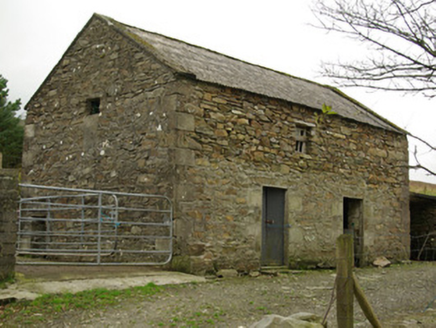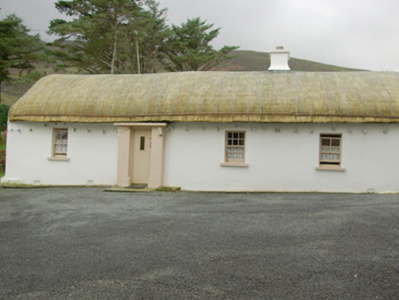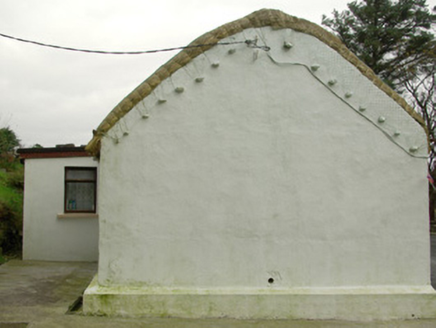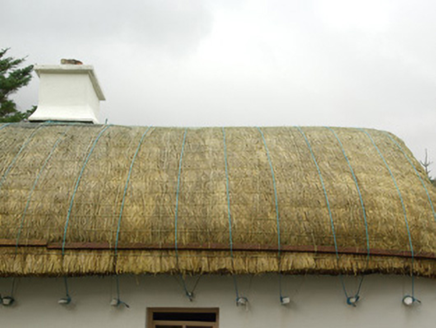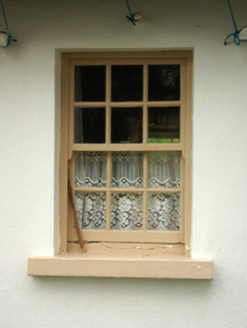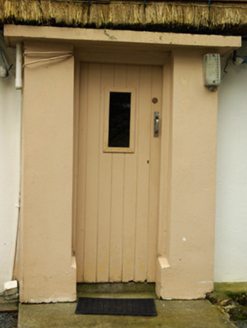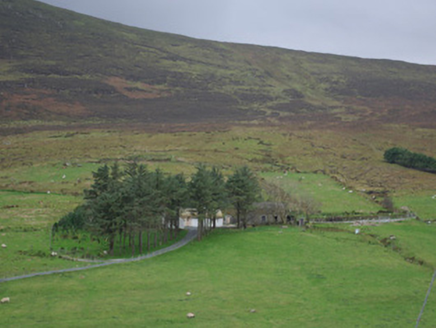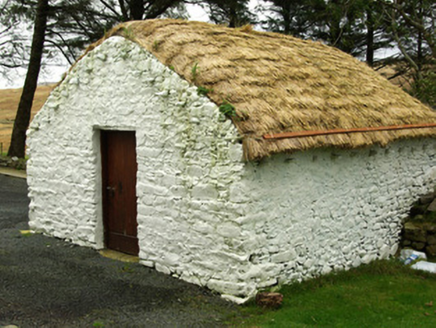Survey Data
Reg No
40909009
Rating
Regional
Categories of Special Interest
Architectural, Technical
Original Use
House
In Use As
House
Date
1840 - 1880
Coordinates
156971, 379618
Date Recorded
31/10/2007
Date Updated
--/--/--
Description
Detached four-bay single-storey vernacular house, built c. 1860, having flat-roofed windbreak porch to main elevation (north-east) and single-storey flat-roofed extension to the rear (south-west). Pitched/domed rope-and-stone peg straw thatch having smooth rendered chimneystack (offset to the north-west side of centre) and having stone pegs for securing ropes/nets over thatch at eaves level to main elevation and to gable ends. Net over roof. Smooth rendered walls with pronounced projecting plinth to the south-east gable end and to the rear elevation (south-west). Square-headed window openings having mainly two-over-two pane timber sliding sash windows and some six-over-six pane timber sliding sash windows. Square-headed door opening to windbreak porch having replacement timber sheeted door with glass panel. Set well back from road in own grounds to the west of An Charraig/Carrick. Site sheltered from winds/weather by shelter belt of trees. Long approach laneway to site from road to the north-east; bridge to laneway over the Owenwee River. Tarmacadam forecourt to front of site (north-east). Detached single-bay single-storey outbuilding to the south-east having pitched thatched roof, rubble stone walls with stone pegs for securing ropes, and square-headed doorway to north-west gable having timber door. Detached two-bay two-storey outbuilding to the north-west having pitched corrugated-metal roof with raised cement rendered verges to gable ends, rubble stone walls, square-headed window opening to first floor level having timber window, and square-headed doorways having battened timber doors.
Appraisal
This charming and well-maintained thatched vernacular house retains its early form and character despite some alterations, and is an appealing feature in the picturesque rural landscape to the west of An Charraig/Carrick. Modest in scale, it exhibits the simple and functional form of vernacular building in Ireland. Of particular interest in the survival of the thatch roof, although recently renewed, which is now sadly becoming increasingly rare in Donegal. The rounded roof is a typical feature of thatched houses located close to the sea in exposed areas in the north-west of Ireland, while the pegs to the eaves were used to tie ropes (and sometimes nets) over the roof to secure it against the prevailing winds, as is the case here at Ballymore. The irregular spacing of the openings to the main elevation lends this building a pleasing vernacular character. This house represents a fine surviving example of a once ubiquitous building type in the rural Irish countryside, and is a valuable addition to the vernacular heritage of County Donegal. The two outbuildings to site, particularly the rubble stone outbuilding with thatched roof, add considerably to the setting and context, and are interesting structures in their own right.
